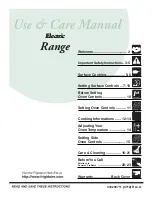
7
Setting Surface Controls
Setting Surface Controls
About the Ceramic Glass Cooktop
The ceramic cooktop has radiant surface elements located
below the surface of the glass. The design of the ceramic
cooktop outlines the area of the surface element underneath.
Make sure
the diameter of the pan matches the diameter of the
element outline on the cooktop (See Figure 1).
Heat is transferred up through the surface of the cooktop to the
cookware. Only flat-bottom cookware should be used. The type
and size of cookware, the number of surface elements in use
and their settings, are all factors that will affect the amount of
heat that will spread to areas beyond the surface elements.
The areas surrounding the elements may become
hot enough
to cause burns.
About the Radiant Surface Elements
The element temperature rises gradually and evenly. As the
temperature rises, the element will glow red. To maintain the
selected setting, the element will cycle on and off. The heating
element retains enough heat to provide a uniform and
consistent heat during the off cycle. For efficient cooking, turn
off the element several minutes before cooking is complete.
This will allow residual heat to complete the cooking process.
Locations of the Radiant Surface Elements and
Controls
Your range is equipped with radiant surface elements with
different wattage ratings. The ability to heat food quicker and in
larger volumes increases as the element wattage increases.
The radiant surface elements are located on the cooktop as
follows:
- One
6 inch
radiant element at the right rear position;
- A
dual 6 or 9 inch
radiant element at the right front position;
- Two
7 inch
radiant elements located at both the left front and
rear positions.
- Between left front and rear elements is a
Bridge
radiant
element. The BRIDGE radiant element is controlled using the
same knob that controls the left front radiant element position.
NOTE
: Please read detailed instructions for ceramic
glass cooktop cleaning in the
General Care &
Cleaning
section and
Before You Call
checklist
section of this Use and Care Guide.
NOTE
: Radiant elements have a limiter that allows the
element to cycle on and off, even at the HI setting.
This helps to prevent damage to the ceramic smooth
top. Cycling at the HI setting is normal and can occur if
the cookware is too small for the radiant element or if
the cookware bottom is not flat (Refer to page 12
under Selecting Surface Cooking Utensils).
NOTE
: Due to the high intensity of heat generated by
the surface elements, the glass surface will turn green
when the element will be turned off. This phenomenon
is normal and the glass will come back to its original
white color after it has completely cooled down. (White
glass cooktops only).
Element On
Element On
Warming
Zone
Right
Front
Large
Element
Small
Element
Right
Rear
Element On
Front
Element
Bridge
Element
Left
Front
Left
Rear
OFF LO
2
3
4
5
6
7
8
9
HI
OFF
HI
HI
6
5
4
3
2
1
LO
6
5
4
3
2
1
LO
OFF
HI
HI
6
5
4
3
2
1
LO
6
5
4
3
2
1
LO
OFF LO
2
3
4
5
6
7
8
9
HI
OFF
MED
HI
LO
Figure 2
Surface Cooking Settings
Use the chart (see Figure 2) to determine the correct
setting for the kind of food you are preparing. The
Simmer settings are used to simmer and keep larger
quantities of foods warm such as stews and soups.
The lower Simmer settings are ideal for delicate foods
and melting chocolate or butter.
Note:
The size and type of cookware used will
influence the setting needed for best cooking results.
Recommended Settings for Surface Elements
Setting
Type of Cooking
HIGH (Hi)
Start most foods, bring water to a
boil, pan broiling
MEDIUM HIGH (5-8)
Continue a rapid boil, fry, deep fat fry
MEDIUM (5)
Maintain a slow boil, thicken sauces
and gravies, steam vegetables
MEDIUM LOW (2 - 4)
Keep foods cooking, poach, stew
LOW (Lo - 2)
Keep warm, melt, simmer
Figure 1








































